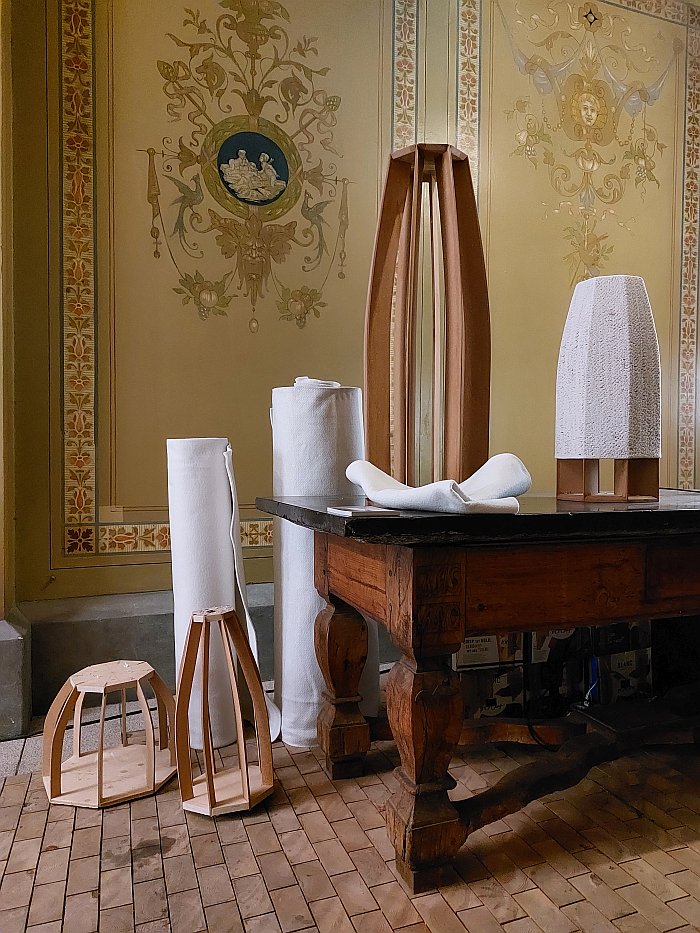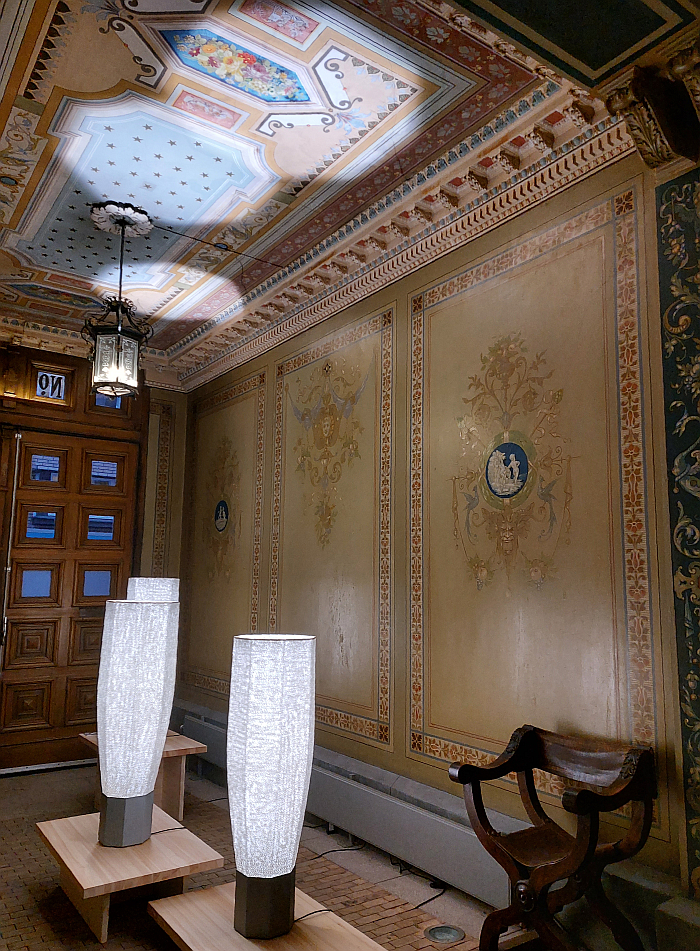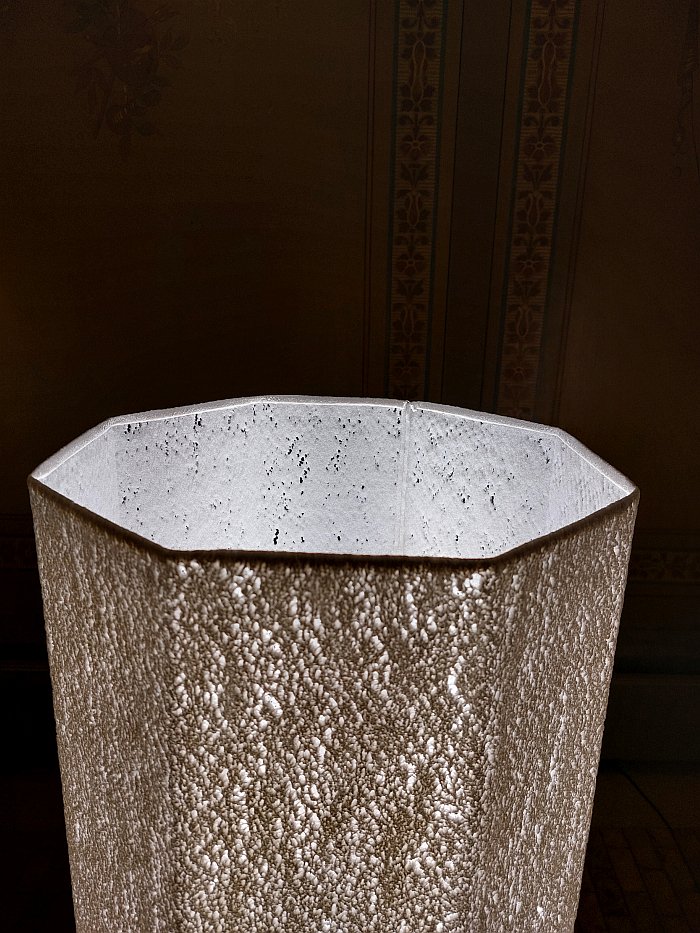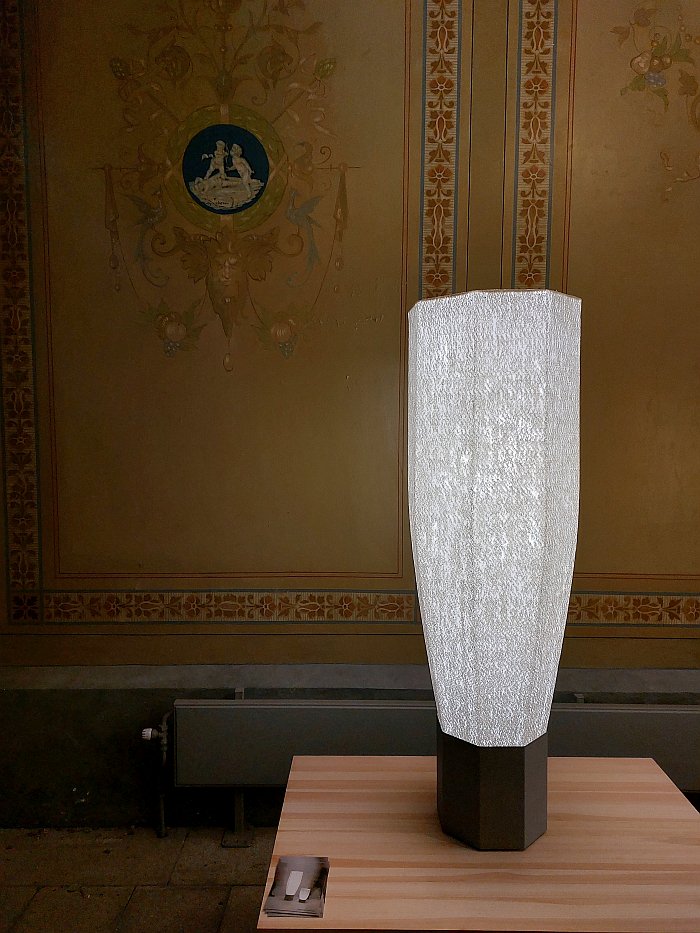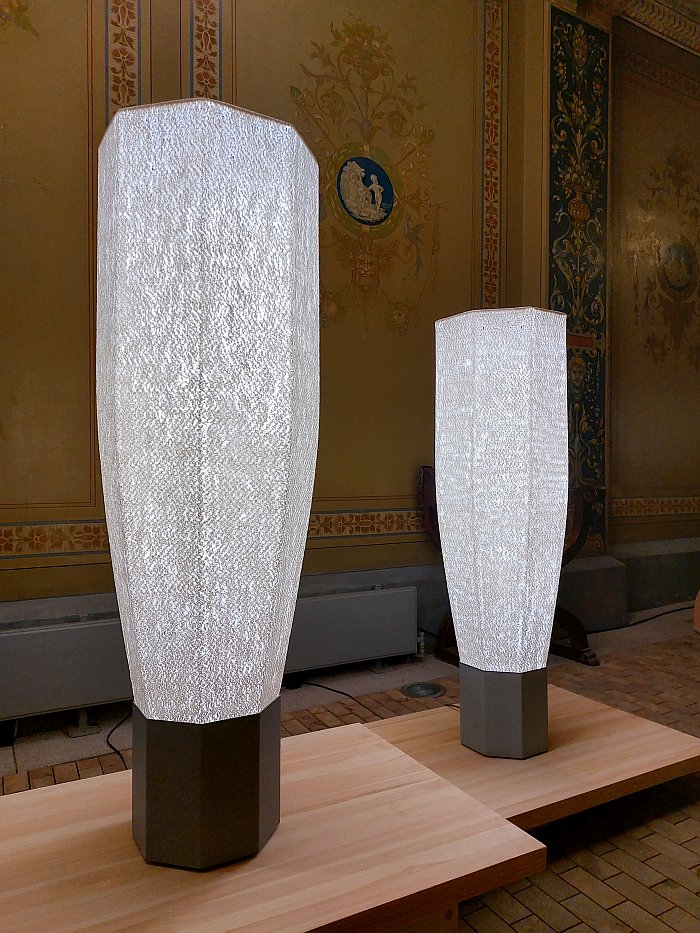
For all that nature is based on, dependent on, carefully formed patterns, repeating order, an efficiency of structure, it is invariably a lack of pattern, order or structure, a randomness and serendipity, that brings about the most fundamental changes, that drives developments in individuals, populations, communities, societies.
And for all that the human spirit is naturally drawn to, and naturally delights in, carefully formed patterns, repeating order, and efficiency of structure, do we not delight more in randomness and serendipity?
A randomness and serendipity that is very much the core of the Burn Lace project by Stockholm based studio Färg & Blanche a.k.a. Fredrik Färg and Emma Marga Blanche.
A Färg & Blanche who, as we always feel obliged to note in the interests of transparency and honesty, were responsible for the exhibition 20 designers at BIOLOGISKA staged during Stockholm Design Week 2011 in BIOLOGISKA, Stockholm's Natural History Museum, a space defined by its multi-floor 360°, immersive, diorama depicting an array of natural habitats populated by stuffed animals, and which for the 20 designers showcase was additionally populated by works from what, today, reads like a snapshot of a dynamic generation of, then, young international design talent seeking their place in the design habitat, including, for example, Kaspar Hamacher, Florian Hauswirth, Mark Braun or Färg & Blanche themselves. Some of the featured 20 have established themselves in that design habitat, others have fallen away, as BIOLOGISKA helps elucidate, that's the inevitable way of these things; and a 20 designers at BIOLOGISKA that remains to this day one our all time favourite experiences. Certainly among the most entertaining and invigorating of design exhibitions we've experienced. The sort of thing we ardently, stridently, miss at the contemporary Stockholm Design Week with its overt commercial focus. Its safety. And an event for which we will always be extremely grateful to Emma and Fredrik.
But not to the extent that we let it cloud our judgment on Färg & Blanche's work. Were it to they'd have featured in these dispatches a lot more over the years than they have.
And while over those years we've taken pleasure in how their career has progressed, and how they have established themselves as one of the more interesting and challenging and entertaining design studios in contemporary Sweden, a design studio it's well worth keeping track of, we've not been taken by everything they've produced.
Are very much taken with their Burn Lace lamps.
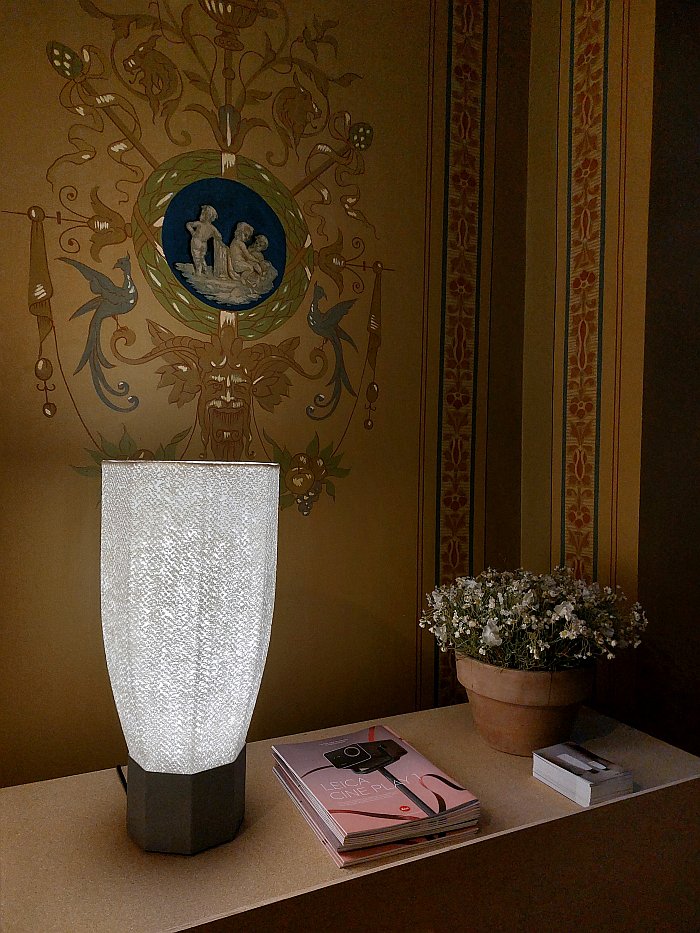
A project that has its origins in a ca 10 year old project, called Burn Lace, that was discontinued on account of a combination of other commitments on the still young, establishing studio's time, and also because of problems in acquiring the necessary material.
With a suitable material sourced, and time having been allocated in the more established studio's practice, the pair picked up the project again. Arguably with a little more focus than the more experimental approach of a decade ago.
The result is a collection of floor and table lamps crafted from a polyester felt which treatment with hot air has left with holes and thinner sections through which light passes, and with intact sections through which light doesn't, or not to the same degree, and which thus creates a mottled, variegated, porous, perforated surface, a surface whose active perforation has been frozen in time. A surface Färg & Blanche talk of as being akin to lace, which we'll disagree with: will argue that while lace is porous and perforated it is also reflective of the carefully formed patterns, repeating order, efficiency of structure of nature, their lamps rely on the randomness and serendipity that brings change and drives development. And which is one of the primary sources of delight in what they have achieved.
A mottled, variegated, porous surface which transforms the light emitted from within in to a distinct, sharp, tangible, but not overbearing luminescence, constructs a wall of crisp light with a discreetness and propriety that is more atmospherically functional than technically functional. Certainly at the lamp level; the funnel, flacon, form of the lamps however meaning that the ceiling above the lamp is bathed in unfiltered, untransformed light, thereby enabling the Burn Lace lamps to offer two levels of indirect lighting. And which posses the question if some form of positionable 'cap' might not be an option to allow for more control of the lighting, of the atmosphere.
A funnel, flacon, form which underscores an unmistakable floral, florid, character that very much echoes one of the foundations on which Art Nouveau was built; an echo of Art Nouveau, arguably, also heard in both the manner in which the mottled, variegated, porous surface provides for a graphic, decorative, effect that isn't ornamental, and also the project's location in craft. Or certainly what appears to be craft, appears to be a craft very close to that of millinery, but is it craft? Or just a process? A process that not only had to be discovered, but whose potential had to be defined. A utilisation of a previously unknown process that would locate Burn Lace in context of numerous other projects in Färg & Blanche's canon, including, for example, the Elastique vases for Målerås, their wood tailoring, or the Succession collection/family that in many regards stands as the pair's breakthrough project and which also has its core an acceptance of the power, value, delight in and of randomness and serendipity. Both a willingness on Färg & Blanche's part to give up a degree of control in the realisation, and also an appreciation of why that is necessary.
But a Burn Lace that is also a craft in that it is based on an interactivity, a collaboration, with the material, with the inalienable inherent properties of the material.
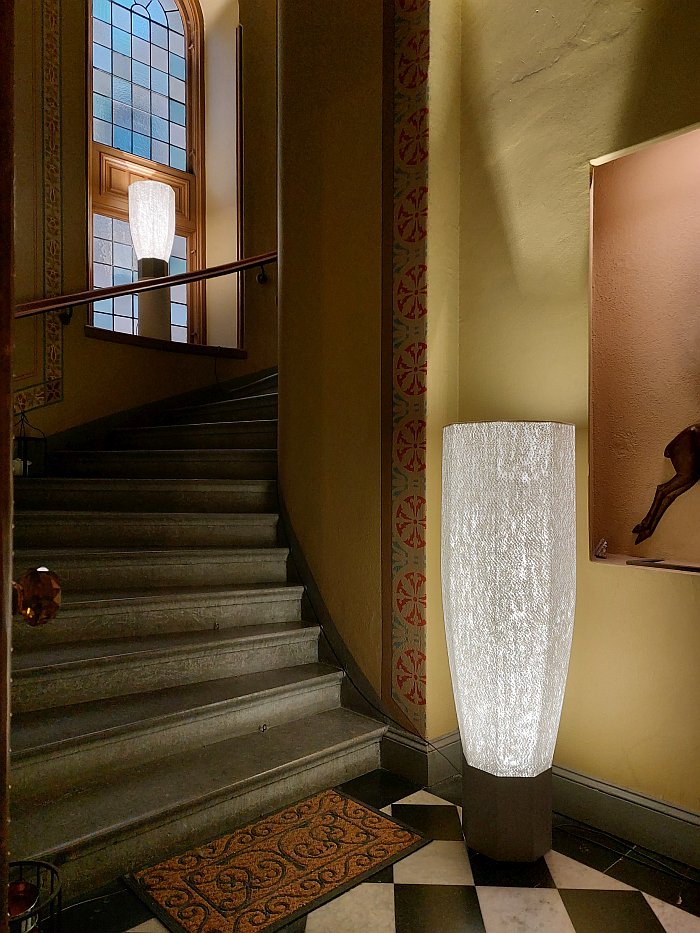
A material, a polyester felt, that is just polyester felt, that requires no metal or other supports to maintain the shape and form, that is all a consequence of the processing, of the crafting. The only addition to the felt being the powder-coated steel base containing the light source. A powder-coated steel base of which we are and were a little unsure, unsure if the formal, material, semantic relationship between the powder-coated steel and the felt works. Would, for example a turned wooden base work better, or a more open, basket-esque base rather than a monumental pedestal? Or do the lamps need the opposition of massive steel and porous, permeated felt? We don't doubt for a minute that Emma and Fredrik haven't ruminated long and hard over such questions, and what you see is their considered answer. But we still pose the questions. The question as why polyester felt and not wool felt we no longer pose as we now know that wool felt doesn't maintain its shape and form after processing, that alone is an aspect of the manipulation of polyester felt by hot air.
A polyester felt, that thanks to its manipulation by hot air and the resulting mottled, variegated, porous, perforated surface presents itself as a very engaging play between ephemerality and permanence, as a solid, immutable object that appears to be in the process of dissolution, a dissolution it never reaches, allows it to inhabit space as an immaterial object; or certainly does when illuminated, unlit it it regains it materiality, resembles a length of formed felt, a solid length of formed felt standing in a space, which isn't a complaint just an observation. One that on the one hand allows one to appreciate a potential acoustic functioning of the lamps and on the other reinforces the felt lamps as an expression of the sort of fabric accessory Modernists, and also Proto-Modernists such as Sweden's own Ellen Key, sought to banish from homes, before a generation of more humanist Modernists including Charles and Ray Eames or Alvar and Aino Aalto began to rehabilitate domestic textiles. A rehabilitation of textiles in interiors domestic and commercial Fredrik Färg and Emma Marga Blanche can be considered as very much advocating and advancing.
A material, a polyester felt, that thanks to its manipulation by hot air is soft, felty, on the inside and crisp to the touch on the outside; a tactile outer texture not unlike the Knäckebröd, crispbread, that used to be produced in the Öhman bakery on Södermalm's Bondegatan Emma's great-great-grandfather once owned, and on whose former site the presentation of Burn Lace took place in context of Stockholm Design Week 2025. Or more accurately, took place in the foyer of the 1889 townhouse that stood on the edge of the factory site; a late-19th century townhouse that in its (near) entirety served as the stage for the pair's 2019 exhibition The Baker's House.
Knäckebröd that as with the pasta discussed from and by al dente: Pasta & Design at the HfG-Archiv, Ulm, represents an artisan staple that in the course of the 19th century became an industrial product, a product of industry, a product for and of industrial society. A process that the Öhman bakery on Södermalm's Bondegatan contributed to and which makes and made the presentation of a felt lamp, a lamp formed from another artisan product that industry claimed for itself, all the more apposite.
Not least as it involves a material that not only was unknown in the 19th century but which only became a reality on account of how the industrialisation initiated in the 19th century has contributed to the material world in which we exist, and the lack of responsibility of that industry, and of the industrial society we are all part of, in their approach to materials. We couldn't make felt from recycled PET bottles if we didn't produce so many single use PET bottles. And also because, even had the material been known, they are lamps realised via a process that back in the day wouldn't have be possible, couldn't have be possible, no-one could have conceived such a process, that took the development of design as a practice separate from craft and applied art to enable the possibly to be seen, approached and grasped. A design that came into its own in conjunction with industry, which is now not only decoupling itself from industry to stand more in the service of society, but critically questioning industry. Which brings us back to Art Nouveau. Or perhaps more accurately Arts and Crafts.
Thus allowing the Burn Lace lamps to not only atmospherically illuminate a space, and potentially acoustically insulate a space, but to allow for reflections on the journey we’ve taken since the mid-19th century, the similarities and differences between then and now, the advances we've made on that journey, the mistakes we’ve made on that journey, and the advances and the mistakes well make going forward.
And of the randomness and serendipity that will define that journey forward as much as, if not more than, the patterns, order and structures we create by way of seeking to control a process as controllable as the manipulation of polyester felt by hot air.
Burn Lace is initially available in a limited series produced by Färg & Blanche. There are intentions to begin serial production, but no definitive plans. Watch this space as it were.
More details on Färg & Blanche can be found at www.fargblanche.com
Stockholm Design Week 2025 has now ended, details on what you missed, on the event in general and when the 2026 edition is being staged, can be found at https://stockholmdesignweek.com
